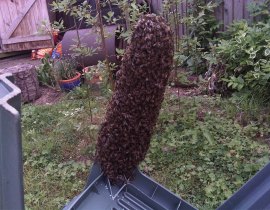Professional Pest Control & Wildlife Management
Bee Swarms
Each spring swarms of bees leave the hives with a fresh new queen looking for a new place to call home. Whilst in transit they resemble what you might expect to see in a cartoon, a mass of insects flying through the air in a flexible oval shape. These swarms of bees will also settle in seemingly quite random places to rest before moving on. Maybe due to the Queens size and shorter wings she is unable to fly long distances without stopping for a break? The result of this pit stop can be a quite frightening mass of bees buzzing through the air and the formation of what can be a football size gathering numbering many thousand hanging on a branch limb.
If in an accessible place these renegade swarms can caught and moved to an awaiting beehive, a service which can be provided by Beekeepers. Please find information here - Swarm Collection (suffolkbeekeepers.co.uk)
- False Widow Spider Removal
- Cluster Fly help
- The trouble with fleas?
- Mole Catching in Suffolk
- Rats in the Garden
- Wasp Nest Control
- Rats in your chicken Coop
- Anaphylaxis
- Bee Swarms
- Becoming a Beekeeper
- Rare Breed Poultry
- Pest Control with Birds of Prey
- Un-marked vehicles available
- Rabbiting with Ferrets
- Myxomatosis
- Poll-Tex Mesh
- Honorary Member Russell Wallis
- Free Rabbit Control


